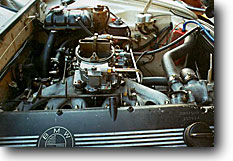|
First thing you have to do is remove the calipers,
by removing the two 19mm bolts, but before you do this, remove
the brake lines and the various bleeder nipples. It is much
easier to work with them when the caliper doesn't move. Take
care not to break off the nipples.
Now that the caliper is off the car, it is necessary
to remove the pistons. This can be a little tricky, so be
careful. You can blow out two of the pistons very easily by
gently applying compressed air to one of the fitting holes
on the caliper, emphasis on the gently. And make sure your
fingers are not in the way, because they tend to pop out at
light speed. Brake fluid will also be flying all over so make
sure you're wearing safety glasses and have any painted surfaces
well covered.
Of course the pistons that pop out will be the
loosest ones. The other two are going to be a bear. Your best
bet is to put the two that popped out back in and hold them
in with some vise grips. Now apply the compressed air again
to pop out the other two. If you?re lucky they?ll pop right
out. But you don't want them to come all the way out, let
them sneak out most of the way and then remove whatever you
have holding the others in place. You want all four to come
out most of the way, so you can finally pop out two, and have
room to get a pair of pliers on the other two. Be careful
with the pliers. You only want to grip the head of the piston.
Do not grip the body of it. Twist until it pops free of the
bore. If you can move them with your fingers, use them instead.
So much for fantasy land. What about the real
world. No matter what you do, one or two of the pistons won't
come out. (If all four pop out of both calipers, be sure to
play the lottery, because you are definitely on a roll.)
The first thing you need to determine is whether
or not the piston is frozen. If the compressed air will not
budge the piston, you can bet it's frozen. It's time to try
the Channelocks. As mentioned above, grip the piston by the
head, not the body. If it's all the way into the bore, you
may not be able to get it out, but if it's sticking part way
out, you should be able to twist and wobble it out. If you
really can?t get the piston out, you?re going to have to replace
the caliper. Get one from a junk yard, and make sure that
all the pistons move, and rebuild it.
OK, now you have the pistons out of their bores,
carefully remove the boots and their retaining rings, and
then you have to remove the rubber seal inside of each bore.
Use a small poker or flat screwdriver, but don't score the
bore.
Do not under any circumstances split the calipers.
For some reason, once they are split, even using new seals,
they always leak.
The next step is to thoroughly clean everything
in solvent. Once the caliper is clean in and out, you must
prepare the bores and polish the pistons. Use a Scotchbrite
pad or some other semi-abrasive. Clean, don't score or sand
the things.
When everything is ready, clean everything once
again but use alcohol this time. The alcohol will help remove
any solvent left in the passageways, but won't destroy the
brake fluid. Blow out all the holes, and let everything dry. |



